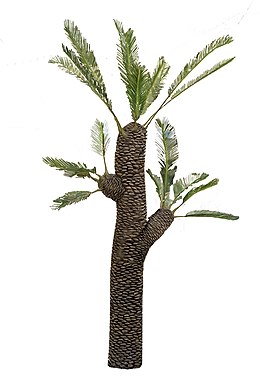
Back البينيتيات Arabic Bennettitales BS Bennettitals Catalan Benetity Czech Bennettitales German Bennettitales Spanish Bennettitales Finnish Bennettitales French Bennettitales ID Bennettitales Italian
| Bennettitales | |
|---|---|

| |
| Restoration of a member of Williamsoniaceae by Thérèse Ekblom | |

| |
| Life restoration of "Williamsonia" sewardiana from the Early Cretaceous of India, which may represent an early member of Cycadeoidaceae | |
| Scientific classification | |
| Kingdom: | Plantae |
| Clade: | Tracheophytes |
| Clade: | Spermatophytes |
| Order: | †Bennettitales Engler, 1892 |
| Families | |
Bennettitales (also known as cycadeoids) is an extinct order of seed plants that first appeared in the Permian period and became extinct in most areas toward the end of the Cretaceous. Bennettitales were amongst the most common seed plants of the Mesozoic, and had morphologies including shrub and cycad-like forms. The foliage of bennettitaleans is superficially nearly indistinguishable from that of cycads, but they are distinguished from cycads by their more complex flower-like reproductive organs, at least some of which were likely pollinated by insects.[1]
Although certainly gymnosperms sensu lato (cone-bearing seed plants), the relationships of bennettitaleans to other seed plants is debated. Their general resemblance to cycads is contradicted by numerous more subtle features of their reproductive systems and leaf structure. Some authors have linked bennettitaleans to angiosperms (flowering plants) and gnetophytes (a rare and unusual group of modern gymnosperms), forming a broader group known as Anthophyta. Molecular data contradicts this, with gnetophytes found to be much more genetically similar to conifers. The exact position of Bennettitales remains uncertain.
- ^ Peñalver, Enrique; Arillo, Antonio; Pérez-de la Fuente, Ricardo; Riccio, Mark L.; Delclòs, Xavier; Barrón, Eduardo; Grimaldi, David A. (2015). "Long-Proboscid Flies as Pollinators of Cretaceous Gymnosperms". Current Biology. 25 (14): 1917–1923. doi:10.1016/j.cub.2015.05.062. PMID 26166781. S2CID 13022302.